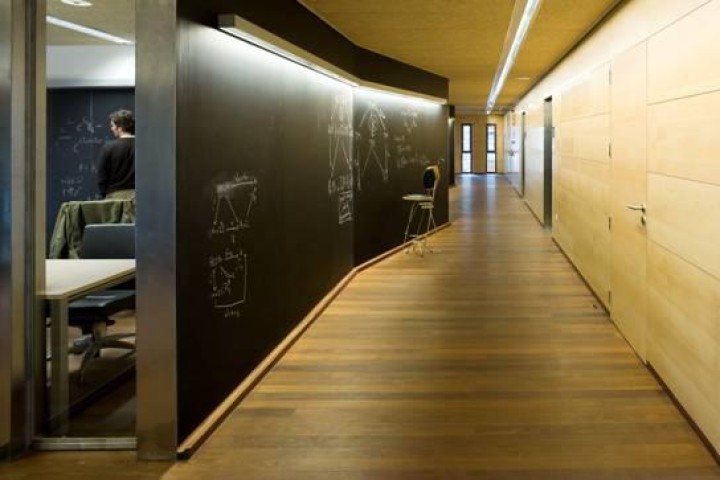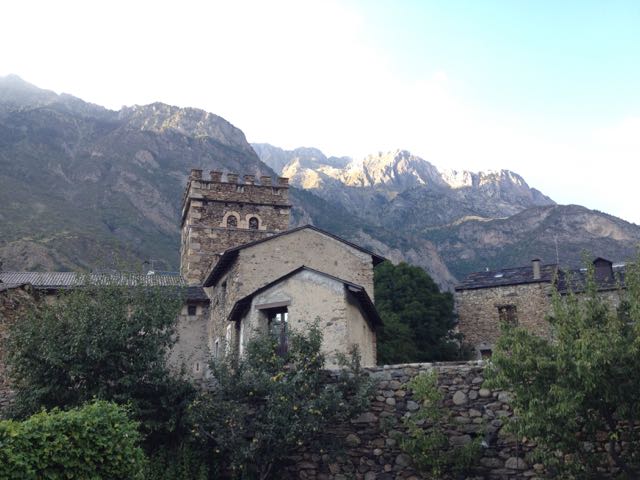Radio interview about TDDFT 2016 conference in Benasque, Spain. My transcript and rough translation.


Radio interview about TDDFT 2016 conference in Benasque, Spain. My transcript and rough translation.


|
Programa: “Aquí la Radio” Segmento: Encuentro científico en Benasque, 19 sep 2016
El Centro de Ciencias 'Pedro Pascual' del municipio oscense de Benasque acoge entre este 20 y este 23 de septiembre un encuentro de 85 científicos de diversos países que analizarán el comportamiento de los electrones. De esta cita habla en Aragón Radio el profesor de la Universidad de California David Strubbe.
[Música]
[Paco Doblas] Bueno, en Aquí la Radio, te contamos una historia muy interestante: Mañana empieza en Benasque un encuentro internacional de científicos al que asisten hasta ochenta y cinco profesionales de todo el mundo, y deban a debatir sobre temas muy complejos para los ciudadanos de a pie: electrones, las reacciones químicas de los materiales o las moléculas. Lo llamativo de la cuestión es entender cómo lugar recóndito maravilloso, precioso, del Pirineo alberga este tipo de cita hasta una cuenta de la cantidad de científicos que se reparten por el mundo. ¿Qué hacen ochenta y cienco científicos de todo el mundo, investigando en Benasque? – Que, dicho de otra forma, o de otro modo, ¿nos encanta que así sea, no? [Ainhara Güerri] Estamos completamente de acuerdo en esto. [discusión ininteligible] [Paco] David Strubbe es profesor de la Universidad de California y está allí en Benasque. Profesor, ¿qué tal? Buenos días. [David] Hola. [Paco] Buenos días, profesor, ¿cómo estamos? [David] Muy bien. [Paco] ¿Qué tal en Benasque? Ameno el sitio que eligió Uds. -- ¿no? -- para ir hablar de sus inventos. [David] Sí, claro, es un sitio lindo para tal una reunión. [Paco] ¿Qué tiene el Centro de Ciencias de Benasque para venir desde la Universidad de California a participar en este encuentro, profesor? [David] Sí, pues, esta reunión es uno de los acentecimientos más importantes en el mundo en este asunto de investigación que tenemos aquí. Tenemos expertos de todas partes del mundo, de Asia, de todas partes de Europa que vienen aquí para discutir nuestra ciencia. [Paco] ¿Cuántos días van a estar en Benasque, hablando de electrones? [David] ¿Cómo? [Paco] ¿Cuántos días van a estar en Benasque, hablando de electrones, profesor? [David] Ah, vale, estamos aquí para dos semanas. La primera semana es como escuela para estudiantes, y en la segunda semana, que empieza mañana, es para discutir la investigación reciente. [Paco] Profesor, a ver, somos de letras, quiero decir que no entendemos mucho de electrones ni de reacciones químicas de los materiales o de las moléculas. No sé por dónde empezar esta entrevista. ¿Qué van a discutir Uds. acerca de los electrones? ¿Cuál es la discusión, el debate científico ahora mismo, relacionado con los electrones? [David] Sí, pues, estamos investigando cosas con relacíon a la interacción con luz con moléculas y materias. Por ejemplo, podemos calcular cuáles son los colores de moléculas, y tiene aplicaciones, cosas como entender mejor la fotosíntesis, que hacen las plantas, y con energía renovable y paneles solares. [Paco] Interesante. ¿Las moléculas tienen color? [David] Sí, claro, como en plantas, que son verdes, viene de las moléculas de clorofilo que tienen adentro. [Paco] Qué bueno. ¿Si tuvieras que ser una molécula, Ainhara, de qué color serías? [Ainhara] Pues, a mí una molécula me pega de fuerte rosa. ¿Hay moléculas rosas, profesor? [David] Sí, claro, por ejemplo, los que vemos en las hojas en otoño, que producen las plantas cuando dejan de producir el clorofilo, que tienen en el verano para generar energía. [Paco] Pues, ahora en Benasque, tiene que estar precioso, con relación del otoño, tiene que estar-- [Ainhara] Por cierto, profesor, ¿cuántos años llevan utilizando este lugar del Pirineo para intercambiar proyectos y también para intercambiar información científica? [David] Sí, pues, ésta es la séptima edición de esta escuela, es la cuarta vez que yo vengo por aquí. [Paco] Profesor, es pronto para hablar evidentemente de las conclusiones, lo haremos gracias por atendernos en esta pequeña entrevista, que nos sirve de aperitivo -- ¿verdad? -- para estas dos semanas que tienen Uds. por delante, para hablar de todo esto, de electrones, de reacciones químicas, de los materiales o de moléculas. Buenos días, un saludo. [David] Muchas gracias. |
Program: “Aquí la Radio” (“Here on the Radio”) Segment: “Scientific meeting in Benasque”, 19 Sept 2016
From September 20 to 23, the Pedro Pascual Science Center in the town of Benasque, Huesca, is welcoming a meeting of 85 scientists from various countries who will analyze the behavior of electrons. University of California professor David Strubbe speaks to Aragon Radio about this meeting.
[Music]
[Paco Doblas] Ok, on Aquí la Radio, we’re telling you a very interesting story: Tomorrow begins in Benasque an international meeting of scientists, which eighty-five professionals are attending from the whole world, and they are debating about subjects which are very complicated for the layperson: electrons, chemical reactions of materials or molecules. The key question here is to understand how a marvellous, beautiful, out-of-the-way place in the Pyrenees hosts this kind of event, even with this number of scientists from all over the world. What are eighty-five scientists from all over the world researching in Benasque? – which, said in another way, in other words, we’re delighted it’s happening, right? [Ainhara Güerri] We are completely in agreement about that. [unintelligible discussion] [Paco] David Strubbe is a professor at the University of California and he is there in Benasque. Professor, how’s it going? Good day. [David] Hello. [Paco] Good day, professor, how are we? [David] Very well. [Paco] How is it in Benasque? It’s a pleasant place you chose for speaking about your inventions, isn’t it? [David] Yes of coure, it is a pretty place for such a meeting. [Paco] What does the Benasque Science Center have that you came from the University of California to participate in this meeting, professor? [David] Yes, well, this meeting is one of the most important events in the world for our subject of research. We have experts from all parts of the world, from Asia, from all parts of Europe, who are coming here to discuss our science. [Paco] How many days will you be in Benasque speaking about electrons? [David] What? [Paco] How many days will you be in Benasque speaking about electrons, professor? [David] Ah, ok, we are here for two weeks. The first week is like a school for students, and in the second week, which starts tomorrow, it’s for discussing recent research. [Paco] Professor, ok, we’re not science people, I mean we don’t understand much about electrons or chemical reactions of materials or molecules. I don’t know where to start this interview. What are you going to discuss about electrons? What is the discussion, the scientific debate right now, with respect to electrons? [David] Yes, well, we are investigating things related to the interaction of light with molecules and matter. For example, we can calculate what are the colors of molecules, and it has applications, things like getting a better understanding of photosynthesis, which plants do, and with renewable energy and solar panels. [Paco] Interesting. Molecules have color? [David] Yes, of course, like in plants, which are green, it comes from the chlorophyll molecules which they have inside. [Paco] Great. If you had to be a molecule, Ainhara, what color would you be? [Ainhara] Well, a bright pink molecule strikes me. Are there pink molecules, professor? [David] Yes, sure, for example, the ones we see in autumn leaves, which plants make when they stop producing chlorophyll, which they have in the summer to generate energy. [Paco] Well, in Benasque now it must be beautiful with the autumn, it must be— [Ainhara] By the way, professor, how many years have you been using this place in the Pyrenees to exchange projects and also to exchange scientific information? [David] Yes, well, this is the seventh edition of the school, it’s the fourth time that I come here. [Paco] Professor, it’s early evidently to talk about conclusions; we thank you for joining us in this little interview, which is like an appetizer for us – right? – for these two weeks you have ahead of you, for talking about all this, of electrons, of chemical reactions of materials and molecules. Good day, cheers. [David] Thank you very much. |